Chapter 9 The commonly accepted definition of hypertension is ‘that level of blood pressure above which investigation and treatment do more good than harm’. Reliable evidence now shows that patients whose blood pressure is consistently >160/90 mm Hg will obtain benefits from drugs that reduce blood pressure. Such treatment reduces the rate of stroke by about 40% and of heart attacks by about 20% (Figure 9.1). Thresholds are lower in high-risk patients, particularly those with existing cardiovascular damage (left ventricular hypertrophy, angina pectoris, prior myocardial infarction, heart failure, transient ischaemic attack (TIA) or stroke), as well as existing diabetes mellitus or chronic renal impairment. Figure 9.1 Meta-analysis of results in 17 randomised placebo-controlled trials of the treatment of hypertension in 47 667 individuals. The mean diastolic BP difference during follow-up was 5–6 mm Hg, mean time from entry to vascular event 2–3 years. In later trials, the reduction in coronary heart disease was nearer to 20%. *Includes any deaths from unknown causes. Source: Reproduced with permission from Collins, R. (1994) British Medical Bulletin, 50, 272–290. © Oxford University Press. Despite efforts by the National Institute of Health and Clinical Excellence (NICE), British Hypertension Society (BHS) and other scientific societies, many patients with hypertension still have poor control of blood pressure, many are not receiving any treatment, and inappropriate drugs are often used. All too often, low drug doses are started with no subsequent dose titration, and unsuitable drug combinations are used. Two (or more) drugs that synergistically reduce blood pressure are better than high-dose monotherapy, which also has a higher risk of side effects. Randomised clinical trials consistently show that a large majority of patients with hypertension need two or more drugs to achieve targets for blood pressure. Monotherapies reduce blood pressure by an average of 7–8%, with some inter-individual variation (Figures 9.2 and 9.3). This is largely a reflection of individual pathophysiological mechanisms, with low renin states being more common in elderly people and Afro-Caribbeans (see Chapter 12). Figure 9.2 Non-placebo-adjusted fall in systolic blood pressure with monotherapy using six different classes of antihypertensive drugs. Source: Data from Sehgal, A.R. (2004) Hypertension, 43, 566–572. Figure 9.3 Non-placebo-adjusted fall in diastolic blood pressure with monotherapy using six different classes of antihypertensive drugs. Source: Data from Sehgal, A.R. (2004) Hypertension, 43, 566–572 Decisions to start treatment in patients with mild hypertension are made on the basis of careful history taking, including family history of premature heart attack or stroke, 12-lead electrocardiography and levels of total and high density lipoprotein cholesterol (TC:HDL). Decisions should be influenced by the patient’s attitude to taking drugs for life, their motivation and their awareness of the risks of hypertension and the benefits of treatment. Guideline committees all stress that patients whose untreated blood pressures are near to thesthresholds for starting treatment or whose pressures settle to below the thresholds on rechecking need careful monitoring about once per year. As blood pressures rise with increasing age, one would expect that 5-10% of these patients would develop hypertension at a level worth treating within 5 years. Decisions on treatment at lower levels of cardiovascular risk should be influenced by the patient’s attitude towards taking antihypertensive medication, possible drug side effects, the proven benefits of blood pressure reduction as well as compliance with dietary and lifestyle modifications. Blood pressures increase within 5 years to levels that clearly need treatment in about 10–15% of such patients. In addition, cardiovascular risk will increase with age, so risk should be reassessed annually. All of these patients should be encouraged to continue with lifestyle measures to reduce blood pressure and cardiovascular risk. The threshold for starting drug treatment is also based on the total cardiovascular risk status. In high-risk patients, the threshold is a blood pressure consistently above 140/90 mm Hg. In low-risk patients, the threshold is 160/100 mm Hg (Figure 9.4). Figure 9.4 The thresholds for starting antihypertensive therapy are recommended by the British Hypertension Society. *Unless malignant phase of hypertensive emergency, confirm over 1–2 weeks, then treat. †If cardiovascular complications, target organ damage or diabetes is present, confirm over 3–4 weeks, then treat; if absent, remeasure weekly and treat if blood pressure persists at these levels over 4–12 weeks. ‡If cardiovascular complications, target organ damage or diabetes is present, confirm over 12 weeks, then treat; if absent, remeasure monthly and treat if these levels are maintained and if estimated 10 year CVD risk is 20%. **Assessed with CVD risk chart. Source: Reproduced with permission from Williams, B., et al. (2004) Journal of Human Hypertension, 18, 139–185. © Nature. The guideline recommends that antihypertensive drug treatment should be offered to people aged 80 years or less with stage 1 hypertension who have one or more of the following: Antihypertensive drug treatment should be offered to people of any age with stage 2 hypertension. For people aged under 40 years with stage 1 hypertension and no evidence of target organ damage, cardiovascular disease, renal disease or diabetes, specialist evaluation to detect underlying causes of hypertension is recommended. There is some evidence that the currently used 10-year cardiovascular risk assessments can underestimate the lifetime risk of cardiovascular events in these people. The 2011 NICE guidance recommends target blood pressure levels in relation to age and whether the pressure is measured in the clinic or at home (Table 9.1). The 2011 NICE guidance provides no recommendations on how far to lower blood pressure in patients with concurrent diabetes or who are at high risk. However, in their 2004 guidelines, the British Hypertension Society recommended lowering blood pressure to 130/80 mm Hg or less. Table 9.1 Targets for antihypertensive drug therapy TOD, target organ damage. Most antihypertensive drugs work primarily by relaxing the smooth muscle cells in the media of the arterioles, leading to a fall in peripheral vascular resistance. This is mainly achieved by blocking the generation or effects of the powerful vasoconstrictor, angiotensin II. The smooth muscle cells also constrict in response to a rise in intracellular calcium, which is blocked by the calcium channel blockers. The β blockers reduce circulating renin and angiotensin levels but they also reduce cardiac output. The diuretics reduce circulating blood volume but also have a direct effect on the arterioles, causing vasodilatation (Figure 9.5). Figure 9.5 Schematic cross section of a peripheral arteriole showing pressor mechanisms and their blockade by antihypertensive drugs. It is now becoming clear that the endothelial cells, lining the arterioles, have local humeral properties, producing both vasoconstrictor (angiotensin and endothelin) and vasodilator (nitric oxide and bradykinin) hormones, which affect the adjacent smooth muscle cells. The ACE inhibitors are a major class of drugs that has transformed the treatment of cardiovascular disease. As the name implies, these drugs block ACE, which converts angiotensin I to angiotensin II, mainly in the lungs. Angiotensin II is a potent arteriolar vasoconstrictor and also stimulates aldosterone release from the adrenal cortex. Aldosterone causes retention of sodium and water. The ACE inhibitors thus cause vasodilatation and reduced renal reabsorption of sodium and water. In addition, angiotensin II has many other properties that may be harmful in vascular disease, and its inhibition (at the local tissue and systemic levels) leads to additional benefits. ACE is also responsible for the breakdown of bradykinin, so the ACE inhibitors increase levels of bradykinin, which enhances vasodilatation. In patients who are fluid depleted, usually because of high doses of diuretics, and those with severe heart failure, bilateral renal artery stenosis and malignant phase hypertension, acute administration of ACE inhibitors may cause a sudden decrease in blood pressure and deterioration in renal function, so caution is needed. Increases in serum levels of creatinine <20% are the result of reversible reductions in intra-glomerular pressure, however, and are acceptable. In the long term, ACE inhibitors preserve renal function and are indicated in most patients with hypertension and renal impairment. The ACE inhibitors also have additional trial evidence for some benefits in coronary artery disease (e.g. perindopril), diabetic retinopathy, systolic heart failure, diabetic and non-diabetic nephropathy, and (possibly) atrial fibrillation. In the Anglo-Scandinavian Cardiac Outcomes Trial (ASCOT), 25% fewer patients randomised to an amlodipine/perindopril-based regimen developed new onset type 2 diabetes mellitus, compared to the β blocker/thiazide regimen. The most common side effect of ACE inhibitors is a persistent, frequently nocturnal, dry cough, which occurs in 10–20% of users. It is more common in women and patients who do not smoke. The cough may not be particularly troublesome, although the complaint sometimes comes from the patient’s partner. Many patients do not realise that their cough is due to their medication, so this symptom is worth enquiring about routinely. All the ACE inhibitors can cause life-threatening acute or sub-acute angiooedema, with swelling of the tongue and lips. This occurs in about one in 4000 white patients but is about four times more common in black people (Figure 9.6). Figure 9.6 Acute angio-oedema in an Afro-Caribbean patient with hypertension. The ACE inhibitors are absolutely contraindicated in women who are pregnant or are likely to become pregnant. They have been reported to be associated with a significant excess frequency of developmental anomalies. However, some detailed studies have not been able to confirm this. The angiotensin receptor blockers (ARB) block the type-I angiotensin II receptors (AT1), which leads to vasodilatation and reductions in blood pressure. Like the ACE inhibitors, the ARB are not only excellent drugs for hypertension but have benefits in stroke reduction, heart failure with left ventricular dysfunction, nephropathy (diabetic and non-diabetic) and after myocardial infarction, where they are at least as good as the ACE inhibitors. In relation to long-term outcomes in hypertension, the ARB are superior to theβ blockers. In the losartan intervention for endpoint (LIFE) study, losartan was superior to atenolol in reducing strokes and there were 25% fewer cases of new-onset type 2 diabetes mellitus. In the valsartan antihypertensive long-term use evaluation (VALUE) trial, a regimen based on valsartan was not superior to a regimen based on amlodipine, although valsartan was associated with fewer cases of new-onset diabetes. There a very limited number of reports of acute angiooedema associated with ARB therapy. Cough does not occur; however, if a patient changes to an ARB because of a cough related to ACE inhibitors, the cough may persist for up to 6 weeks. There is very little information about ARB use in pregnancy, but at the present state of knowledge, they should not be used in women who are pregnant or are likely to become pregnant. Calcium channel blockers (CCB) act by inhibiting the transfer of calcium ions across smooth muscle cell membranes, which produces arteriolar vasodilatation. The systolic hypertension in Europe (SYST-EUR) trial and two other long-term outcome trials validated their use as first-line drugs in patients with hypertension. CCB are useful antianginal and antihypertensive drugs. Non-dihydropyridine CCB (diltiazem and verapamil) block calcium channels in cardiac myocytes. This reduces cardiac output and may have some antiarrhythmic action on the atrioventricular node. The dihydropyridineCCB (such as nifedipine, amlodipine and felodipine) block L type calcium channels in vascular smooth muscle cells. This causes vasodilatation and reductions in vascular resistance and arterial blood pressures. These agents have little effect on the atrioventricular node but do have some mild diuretic effects. Some formulations of dihydropyridine CCB (such as short acting nifedipine capsules) have a rapid onset of action and unpredictable effects on blood pressure, and they may cause reflex sympathetic stimulation, tachycardia and activation of the renin-angiotensin-aldosterone system. Nifedipine capsules bitten or swallowed should never be used in the treatment of hypertensive emergencies and urgencies, and may result in significant cerebral or cardiac ischaemia. Longer acting formulations of dihydropyridine CCB (such as chlortalidone, indapamide bendroflumethiazide and hydrochlorothiazide) cause less neurohumoral activation. Amlodipine is a slow-onset, slow-offset, long-acting calcium blocher, so it is not suitable for use in hypertensive emergencies and urgencies. Dose titration from 5 to 10 mg once daily should be employed at 1–2-week intervals. Side effects include headache and flushing, but the most troublesome side effect is dose-dependent peripheral oedema. This is the result of transudation of fluid from the vascular compartments into the dependent tissues because of precapillary arteriolar dilatation. It is not responsive to diuretics and is common when amlodipine 10 mg is used. Gum hypertrophy is common with dihydropyridineCCB but is less commonly seen with verapamil or diltiazem (Figure 9.7). This gum hypertrophy can be minimised with scrupulous dental hygiene. If, despite this, the gum hypertrophy is troublesome, it is best to consider changing to diltiazem or verapamil. Figure 9.7 Gum hypertrophy caused by amlodipine. Whilst non-dihydropyridine CCB cause less peripheral oedema, they are negatively inotropic (especially verapamil) and negatively chronotropic. Thus, diltiazem and verapamil are contraindicated in left ventricular systolic dysfunction, but may be useful to control the ventricular response in patients with atrial fibrillation. These two drugs should not be used in patients already receiving a β blockers. All CCB, but particularly verapamil, can alter bowel habit and occasionally cause troublesome constipation. This side effect can be turned to a benefit in some patients with irritable bowel syndrome and hypertension. The thiazide and thiazide-like diuretics (chlortalidone and indapamide) are cheap, easy to use and can be given once daily. They are effective and are drugs of choice in elderly people and those of African origin who cannot tolerate a CCB. They are also useful in combination with ACE inhibitors, ARB and β blockers. These drugs reduce blood pressure by increasing excretion of sodium and water, which lowers blood volume, but they also have some vasodilating properties. The reduction in blood volume results in reflex activation of the renin-angiotensin-aldosterone system, which leads to an increase in peripheral vascular resistance that may attenuate the reduction of blood pressure. This effect is smaller in patients with low baseline plasma levels of renin (such as in elderly people and those of African origin). The antihypertensive effect of thiazides is slow, and when used as monotherapy, the dose-response curve is relatively flat, so increasing doses give limited additional reductions in blood pressure (Figure 9.8). This dose-response curve may alter when thiazide diuretics are added to the angiotensin blocking agents (ACE inhibitors or ARB), where higher doses do have an added antihypertensive effect. The adverse metabolic effects of the thiazides are, however, increased at higher doses, with more hypokalaemia, hyperuricaemia and hyperglycaemia. The lowest possible doses are therefore used (e.g. indapamide 1.5 mg). Figure 9.8 Effects of placebo and bendroflumethiazide (2.5 or 5 mg daily) on diastolic blood pressure and serum potassium levels. Source: Data from Carlson, M., et al. (1990) British Medical Journal, 300, 975–978.
The pharmacological treatment of hypertension and endovascular renal sympathetic denervation
When to use drugs
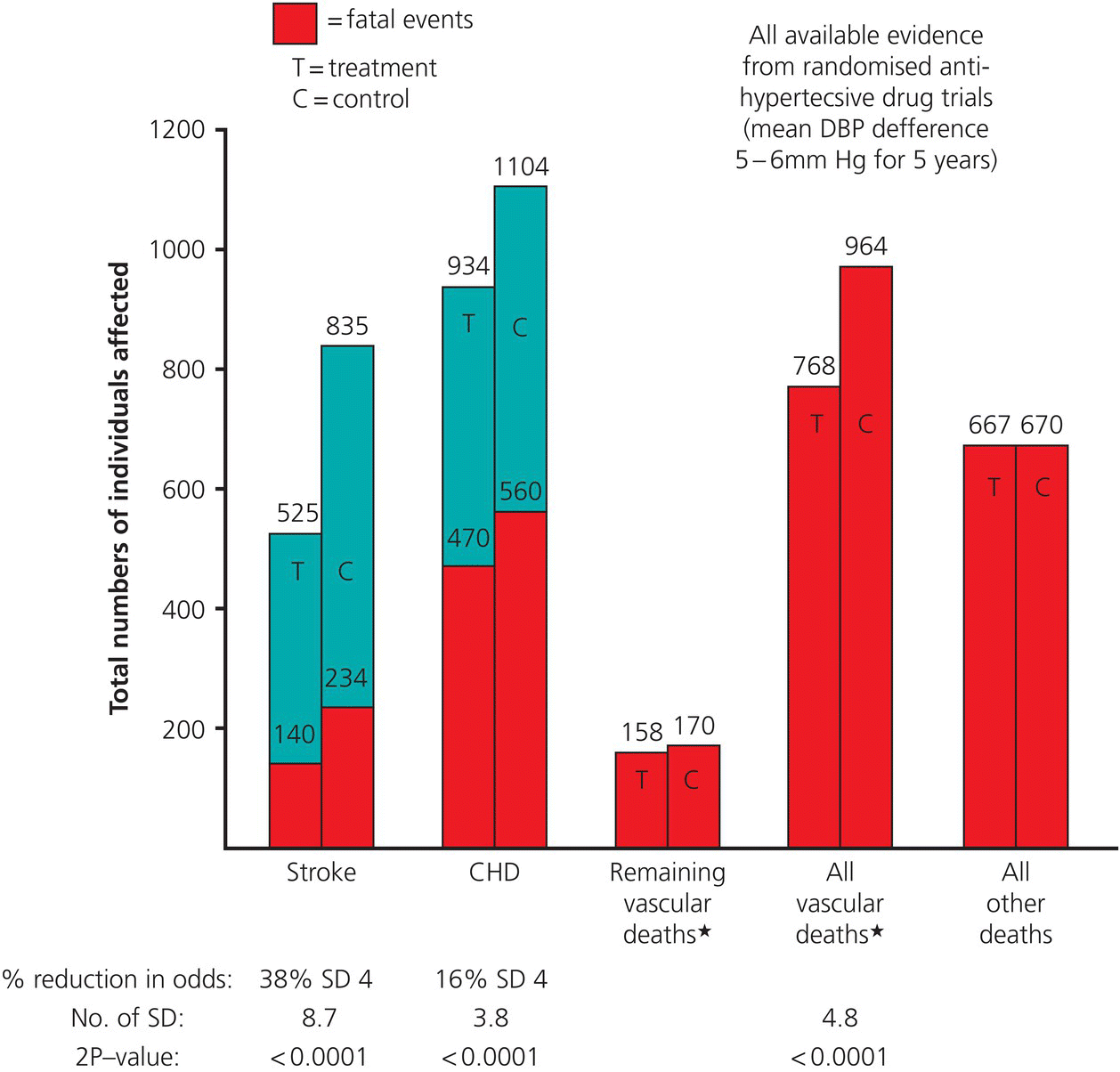
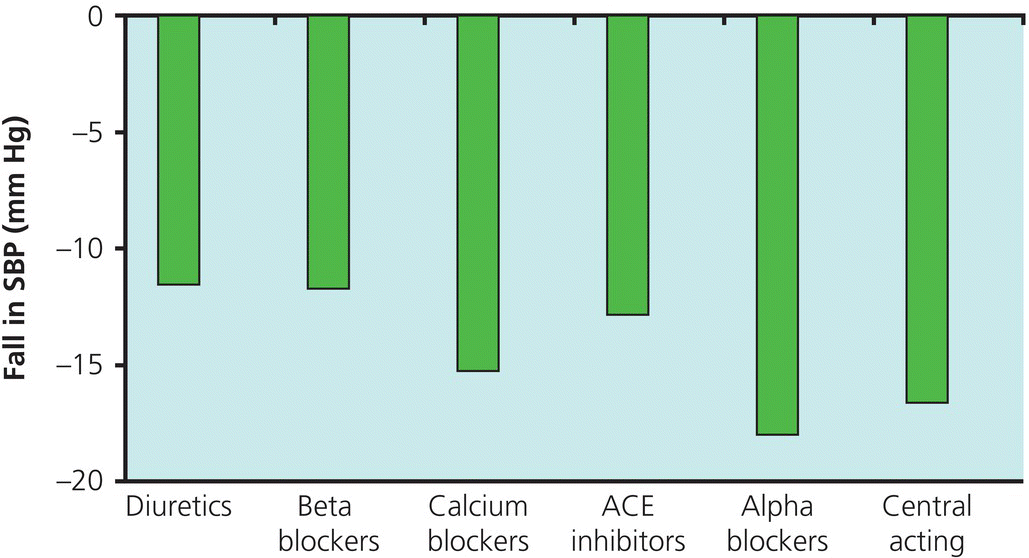
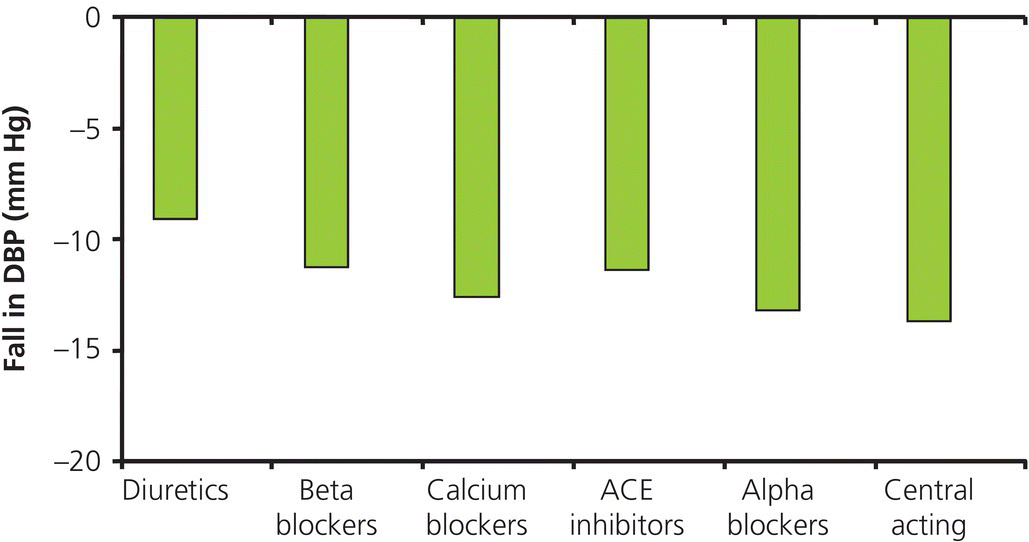
Thresholds
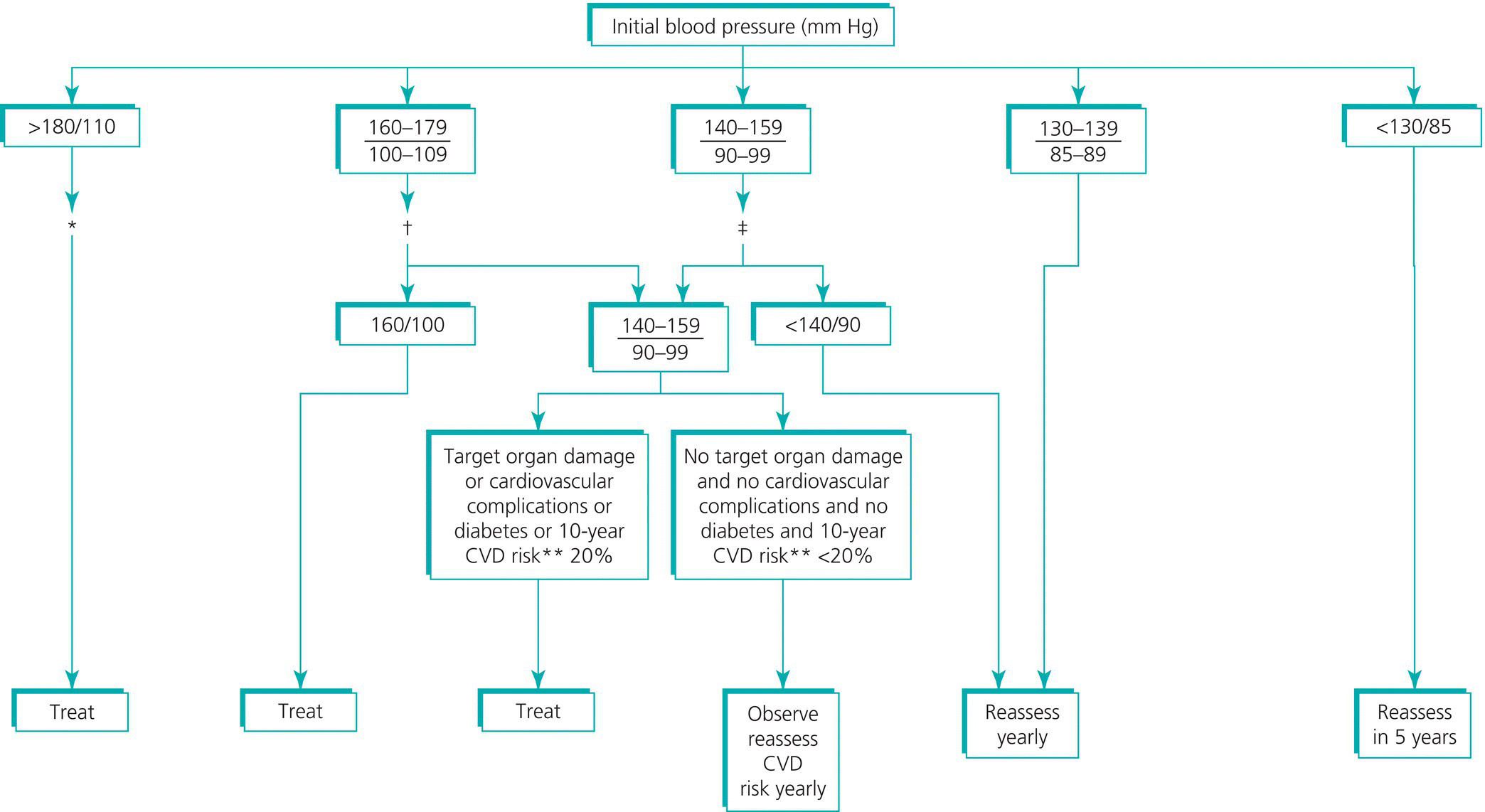
The 2011 NICE/BHS guideline recommendations
Initiating Treatment
Monitoring treatment and blood pressure targets
Clinic or office BP
Daytime ambulatory or home BP
Under age 80
140/90
130/85
Over age 80
150/90
145/85
Diabets or TOD
130/80
—
A review of antihypertensive drugs
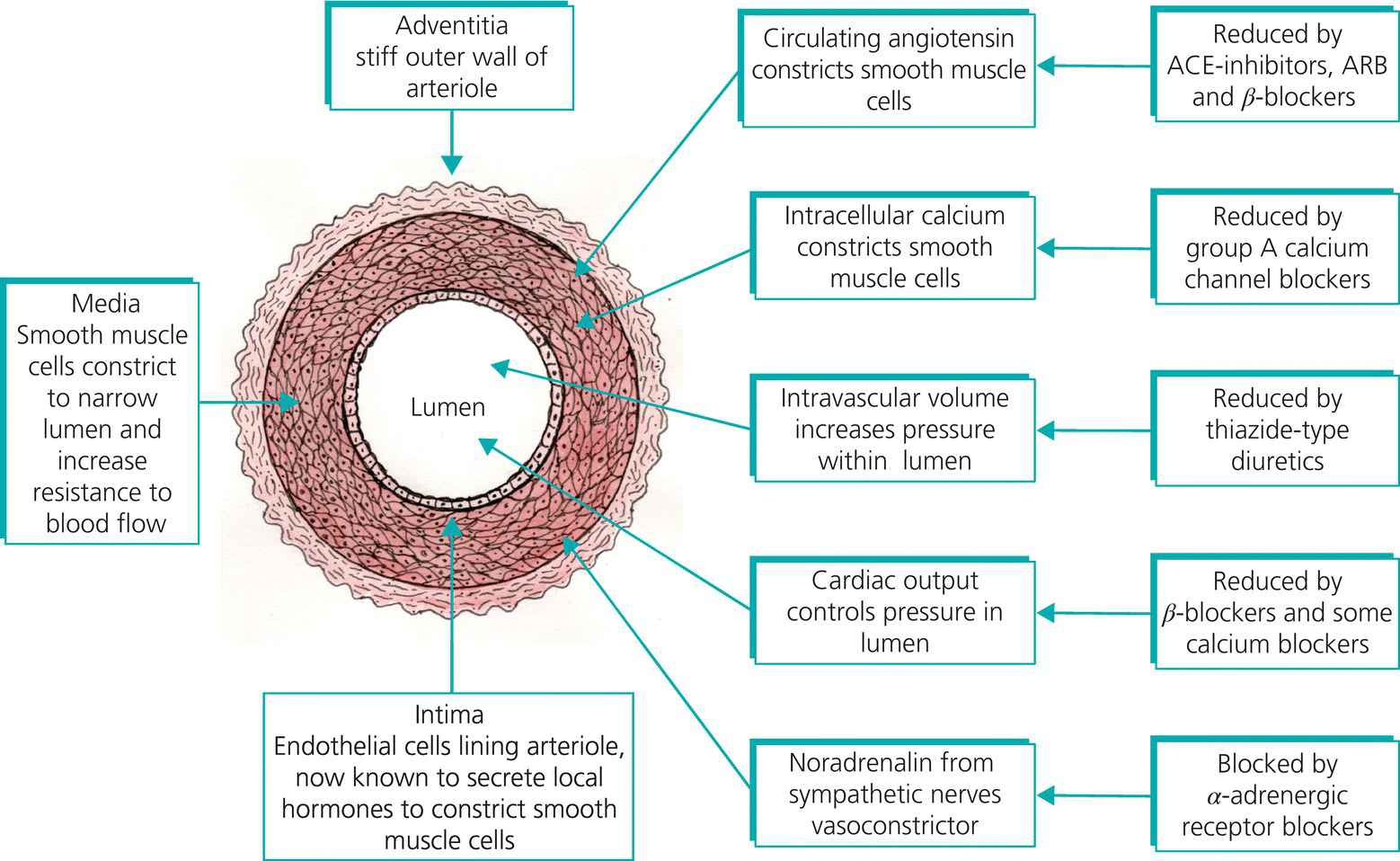
Angiotensin-converting enzyme (ACE) inhibitors
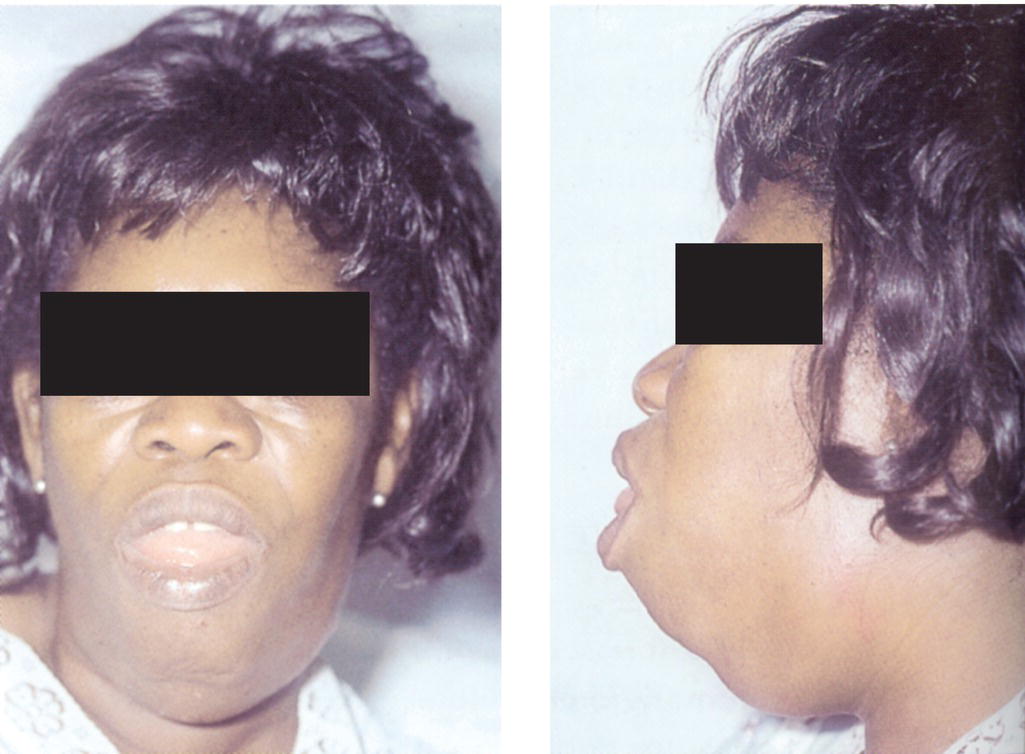
Angiotensin receptor blockers
Calcium channel blockers
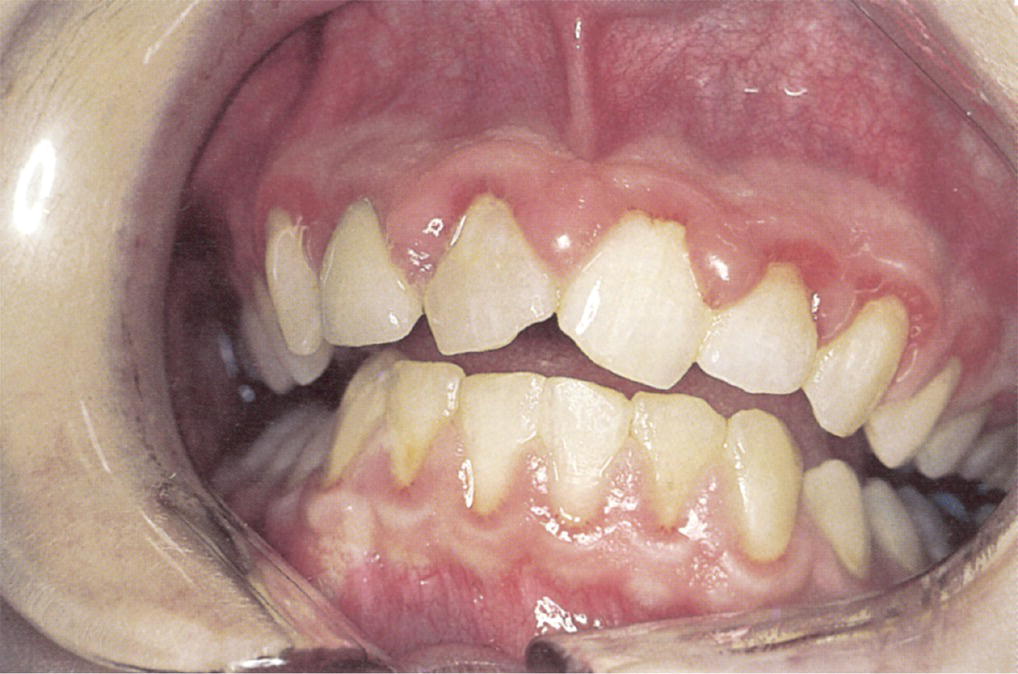
Diuretics
Thiazide diuretics and thiazide-like diuretics
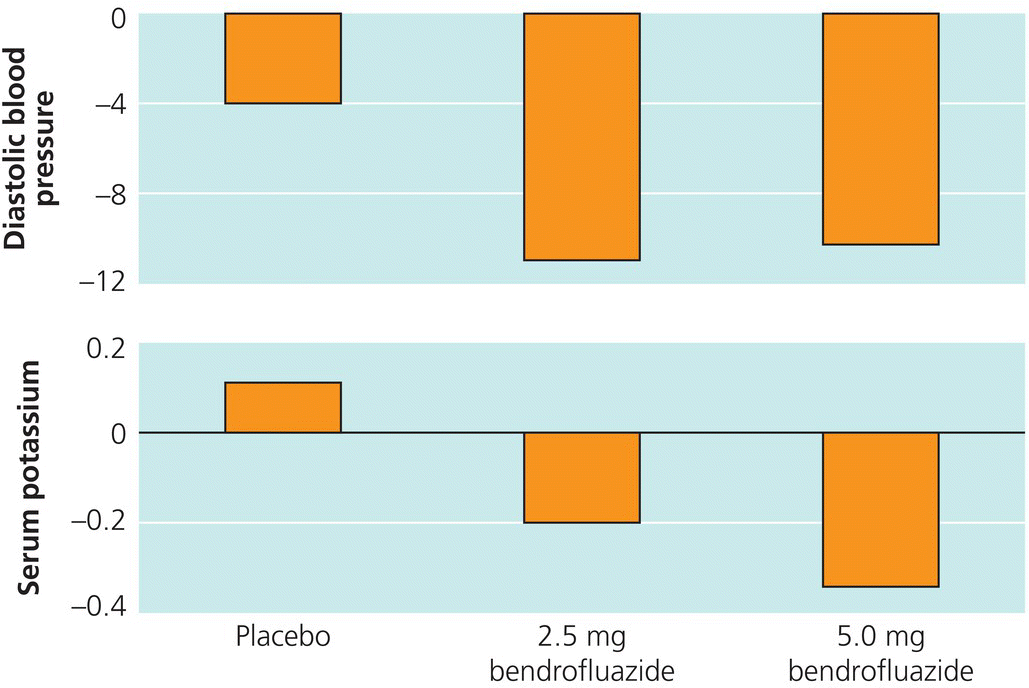
The pharmacological treatment of hypertension and endovascular renal sympathetic denervation
Only gold members can continue reading. Log In or Register to continue

Full access? Get Clinical Tree


